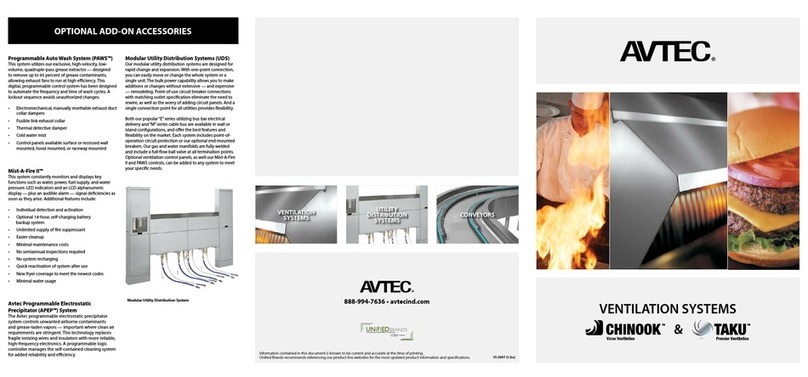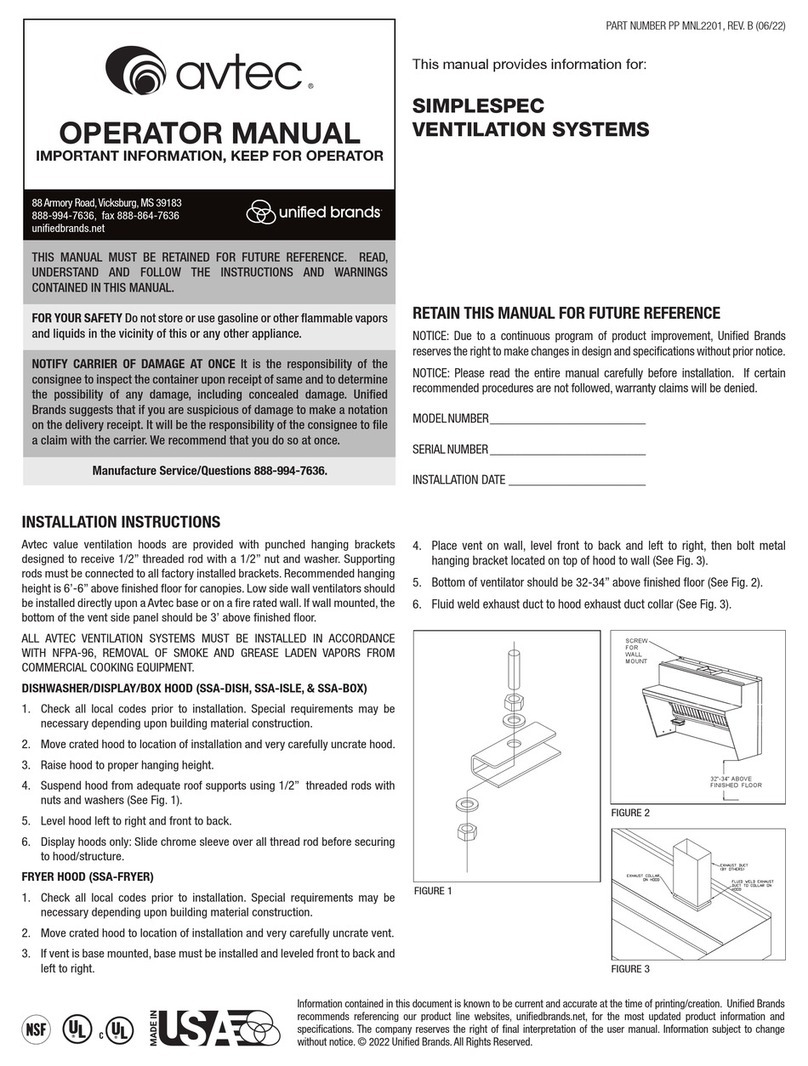
OM-ECOARCH 5
Avtec hoods are provided with adjustable hanging brackets designed to receive 1/2”
threaded rod with a 1/2” nut and washer. Supporting rods must be connected to all
factory supplied/installed brackets. Recommended hanging height is 6’-6” above
finished floor for canopies.
ALL AVTEC VENTILATION SYSTEMS MUST BE INSTALLED IN ACCORDANCE WITH NFPA-
96, REMOVAL OF SMOKE AND GREASE-LADEN VAPORS FROM COMMERCIAL COOKING
EQUIPMENT.
1. Check all local codes prior to installation. Special requirements may be necessary
depending upon building material construction.
2. Move crated hood to location of installation and very carefully uncrate hood.
3. Raise hood to proper hanging height.
4. Suspend hood from adequate roof supports using 1/2” threaded rods with nuts and
washers (See Fig. 1).
5. Level hood left to right and front to back.
6. Brackets are provided for hoods which are to be installed end to end or back to back.
Bolt brackets together using 3/8” bolt through holes provided (See Fig. 2).
7. Install C channel where the ends of the hood meet and install T moldings on front
face of hoods where they join. High temperature silicone can be used to install
channel and T moldings (See Fig. 3).
8. For make-up air hoods, the supply collar with built-in UL listed damper and air
volume damper must be installed per instructions on collar.
9. Provide a removable service door in supply duct near damper (See Fig. 4).
Installation Instructions
INSTALLATION
REQUIREMENTS FOR
ALL AVTEC ECOARCH
VENTILATION HOODS
CANOPIES
Installation Instructions
INSTALLATION REQUIREMENTS
VENTILATION HOODS
CANOPIES
Figure 1 Figure 2
HANGER BRACKET DETAIL
S.S. NUT & BOLT
BY OTHERS
HANGER ROD
HANGER ROD
NUT
Avtec hoods are provided with adjustable hanging brackets designed to receive 1/2”
threaded rod with a 1/2” nut and washer. Supporting rods must be connected to all factory
installed brackets. Recommended hanging height is 6’-6” above finished floor for
canopies. Low side wall ventilators should be installed directly upon a Avtec base or on a
rerated wall. If wall mounted, the bottom of the vent should be 36” above finished floor.
ALL AVTEC VENTILATION SYSTEMS MUST BE INSTALLED IN ACCOR-
DANCE WITH NFPA-96, REMOVAL OF SMOKE AND GREASE-LADEN
VAPORS FROM COMMERCIAL COOKING EQUIPMENT.
1. Check all local codes prior to installation. Special requirements may be necessary
depending upon building material construction.
2. Move crated hood to location of installation and very carefully uncrate hood.
3. Raise hood to proper hanging height.
4. Suspend hood from adequate roof supports using 1/2" threaded rods with nuts
and washers (See Fig. 1).
5. Level hood left to right and front to back.
6. Brackets are provided for hoods which are to be installed end to end or back to back.
Bolt brackets together using 3/8" bolt through holes provided (See Fig. 2).
7. Install C channel where the ends of the hood meet and install T moldings on front
face of hoods where they join. High temperature silicone can be used to install
channel and T moldings (See Fig. 3).
8. For make-up air hoods, the supply collar with built-in UL listed damper and
air volume damper must be installed per instructions on collar.
9. Provide a removable service door in supply duct near damper (See Fig. 4).
Figure 3 Figure 4
EXHAUST DUCT
INSULATED
PRE-DRILLED
HOLE, ACCEPTS
UP TO 1/2"ÿ ROD
PRE-DRILLED
HOLE, ACCEPTS
5/16" BOLT
HOOD
ANGLE
OF HOOD
NOTE: HOLES DRILLED THROUGH HOOD ANGLE BY
INSTALLER AFTER BRACKET ATTACHMENT
POINTS HAVE BEEN DETERMINED.
HOOD FACE
T-MOLDING
C-CHANNEL
SUPPLY DUCT
ACCESS
PANEL
FIRE DAMPER &
VOLUME CONTROL
DAMPER
FLUID WELD





























